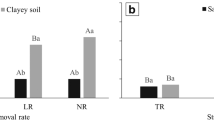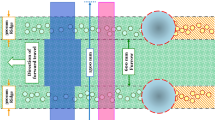Abstract
The high load and tough nature of loose trash generated after sugarcane harvest hampers the fertiliser placement and other field operations; therefore, open burning is a common practice in ratoon sugarcane. In situ retention of sugarcane trash can play an important role in replenishing soil quality and reducing environmental pollution, but there is a lack of suitable machine for placement of fertilisers. To address this and other issues for low yields of ratoon sugarcane, a prototype of multi-purpose machine was developed for operations like stubble shaving, off-barring, root pruning and drilling of basal fertilisers, and evaluated with ten on-farm trials on black soils varying in texture (clay 27–44 % and fertility (Org-C 4.4–9.3 g kg−1). The improvement in cane yields averaged 16 and 11 % over the trash burning (farmer’s practice) and chopping followed by recommended practices of fertiliser application (0.45, 0.45 and 0.10 N as basal, at earthing-up and onset of monsoon rains, respectively) while the nitrogen uptake efficiency (NUE) improved by 9.9 %. Band placement of double the dose of N as basal rather than the recommended two splits as basal and at earthing-up further boosted the initial growth and improved the cane yields and NUE by 22 and 11 % over farmer’s practice. Therefore, the fine-tuning of this prototype should offer a practical and economic solution of trash burning problem in sugarcane cultivation.




Similar content being viewed by others
References
Ahmed, S.N., and S. Giridharan. 2000. Study on the influence of management practices on sugarcane ratoon crop. Indian Sugar 49(10): 835–837.
Arbex, M.A., L.C. Martins, R.C. de Oliveira, L.A.A. Pereira, F.F. Arbex, J.E.D. Cancado, P.H.N. Saldiva, and A.L.F. Braga. 2007. Air pollution from biomass burning and asthma hospital admissions in a sugar cane plantation area in Brazil. Journal of Epidemiology and Community Health 61: 395–400.
Bakker, H. 1999. Sugarcane cultivation and management, 207. New York: Springer.
Basanta, M.V., D. Dourado-Neto, K. Reidchardt, O.O.S. Bacchi, J.C.M. Oliveira, P.C.O. Trivelin, L.C. Timm, T.T. Tominaga, V. Correchel, F.A.M. Cassaro, L.F. Pires, and J.R. de Macedo. 2003. Management effects on nitrogen recovery in a sugarcane crop grown in Brazil. Geoderma 116: 235–248.
De Resende, A.S., R.P. Xavier, O.C. de Oliveira, S. Urquiaga, B.J.R. Alves, and R.M. Boddey. 2006. Long-term effects of pre-harvest burning and nitrogen and vinasse applications on yield of sugar cane and soil carbon and nitrogen stock on a plantation in Pernambuco, NE Brazil. Plant and Soil 281: 339–351.
Denmead, O.T., C.L. Mayocchi, and F.X. Dunin. 1997. Does green cane harvesting conserve soil water? Proceedings of the Australian Society of Sugar Cane Technologists 18: 139–146.
Fortes, C., P.C.O. Trivelin, and A.C. Vitti. 2012. Long-term decomposition of sugarcane harvest residues in Sao Paulo state, Brazil. Biomass and Bioenergy 42: 189–198.
Gomathi, R., P.N.G. Rao, P. Rakkiyappan, B.P. Sundara, and S. Shiyamala. 2013. Physiological studies on ratoonabilty of sugarcane varieties under tropical Indian condition. American Journal of Plant Sciences 4: 247–281.
Gomez, K.A., and A.A. Gomez. 1984. Statistical procedures for agricultural research, 2nd ed, 680. New York: Wiley.
Graham, M.H., and R.J. Haynes. 2005. Organic matter accumulation and fertilizer-induced acidification interact to affect soil microbial and enzyme activity on a long-term sugarcane management experiment. Biology and Fertility of Soils 41(4): 249–256.
Gupta, R., and Ashok Seth. 2007. A review of resource conserving technologies for sustainable management of the rice–wheat cropping systems of the Indo-Gangetic plains (IGP). Crop Protection 26: 436–447.
Hemwong, S., B. Toomsan, G. Cadisch, V. Limpinuntana, P. Vityakon, and A. Patanothai. 2009. Sugarcane residue management and grain legume crop effects on N dynamics, N losses and growth of sugarcane. Nutrient Cycling in Agroecosystems 83: 135–151.
Hobbs, P.R., K. Sayre, and R. Gupta. 2008. The role of conservation agriculture in sustainable agriculture. Philosophical Transactions of the Royal Society B 363: 543–555.
Hunsigi, G. 2001. Ratoon management. In Sugarcane in agriculture and industry, ed. Hunsigi, G., 217. Bangalore: Prism Books.
Ng Cheong, L.R., and M. Teeluck. 2015. The practice of green cane trash blanketing in the irrigated zone of Mauritius: effects on soil moisture and water use efficiency of sugarcane. Sugar Tech. doi:10.1007/s12355-015-0374-1.
Olivier, F.C., and A. Singels. 2007. Effect of a trash blanket on irrigation water use efficiency of sugarcane. Proceedings of the International Society of Sugar Cane Technologists 26: 404–408.
Prasertsak, P., J.R. Freney, O.T. Denmead, P.G. Saffigna, B.G. Prove, and J.R. Reghenzani. 2002. Effect of fertilizer placement on nitrogen loss from sugarcane in tropical Queensland. Nutrient Cycling in Agroecosystems 62: 229–239.
Robertson, F.A., and P.J. Thorburn. 2007. Management of sugarcane harvest residues: consequences for soil carbon and nitrogen. Australian Journal of Soil Research 45: 13–23.
Srivastava, T.K., M. Lal, and S.K. Shukla. 2012. Agronomic research in sugar crops: an overview. Indian Journal of Agronomy 57(3rd IAC Special Issue): 83–91.
Shukla, S.K., R.L. Yadav, A. Suman, and P.N. Singh. 2008. Improving rhizospheric environment and sugarcane ratoon yield through bioagents amended farm yard manures in udic Ustochrept soil. Soil and Tillage Research 99: 158–168.
Singh, P., R.K. Rai, A. Suman, T.K. Srivastava, K.P. Singh, and R.L. Yadav. 2013. Ratooning induced rhizospheric changes impede nutrient acquisition and growth in sugarcane ratoon crop during grand growth stage in sub-tropics. Sugar Tech 15(1): 52–64.
Sundara, B., and B.K. Tripathi. 1989. Available N changes and N balance under multi ratooning of sugarcane varieties in tropical vertisol. Proceedings of the International Society of Sugar Cane Technologists 23: 80–88.
Vallis, I., W.J. Parton, B.A. Keating, and A.W. Wood. 1996. Simulation of the effects of trash and N fertilizer management on soil organic matter levels and yields of sugarcane. Soil and Tillage Research 38: 115–132.
Verma, R.S. 2002. Sugarcane ratoon management, 202. Lucknow: International Book Distributing Co. Pvt. Ltd.
Weier, K.L. 1994. Nitrogen use and losses in agriculture in subtropical Australia. Fertilizer Research 39: 245–257.
Wood, A.W. 1991. Management of crop residues following green harvesting of sugarcane in north Queensland. Soil and Tillage Research 20: 69–85.
Yadav, R.L., S.K. Shukla, A. Suman, and P.N. Singh. 2009. Trichoderma inoculation and trash management effects on soil microbial biomass, soil respiration, nutrient uptake and yield of ratoon sugarcane under subtropical conditions. Biology and Fertility of Soils 45: 461–468.
Yadvinder-Singh, Manpreet-Singh, H.S. Sidhu, E. Humphrerys, H.S. Thind, M.L. Jat, J. Blackwell, and V. Singh. 2015. Nitrogen management for zero till wheat with surface retention of rice residues in north-west India. Field Crops Research. doi:10.1016/j.fcr.2015.03.025.
Author information
Authors and Affiliations
Corresponding author
Rights and permissions
About this article
Cite this article
Choudhary, R.L., Wakchaure, G.C., Minhas, P.S. et al. Response of Ratoon Sugarcane to Stubble Shaving, Off-barring, Root Pruning and Band Placement of Basal Fertilisers with a Multi-purpose Drill Machine. Sugar Tech 19, 33–40 (2017). https://doi.org/10.1007/s12355-016-0438-x
Received:
Accepted:
Published:
Issue Date:
DOI: https://doi.org/10.1007/s12355-016-0438-x




